[Pictures of Mitla courtesy of Rene Cabrerra, Las Bugambilias B&B Tours, Nikhol Esteras Photographer]

Casa de Las Bugambilias B&B
“Spicy foods were [considered] stimulants. They were classified as stimulants, so they were on that same continuum along with caffeine and alcohol all the way up to cocaine and heroin. And if you started with an olive, you might find yourself one day addicted to opiates. It put you on a very slippery slope — watch out for olives!”
Jane Ziegelman, co-author of A Square Meal: A Culinary History of the Great Depression
“—very popular error: having the courage of one’s convictions—? Rather it is a matter of having the courage for an attack on one’s convictions!!!”
Friedrich Nietzsche
I’m not a Bellow scholar, a Calvino scholar, a scholar of any kind at all. I write about what pleases me. I read these two stories in Oaxaca. They affected me in ways that I want to understand. I write so that I can understand. If you want a professional analysis, go elsewhere, but by all means read the two stories on your own if you are so inclined. They are good stories even if my meanderings through them are pedestrian.
I don’t know if Saul Bellow and Italo Calvino knew each other or what they thought about each other. What interests me is the two fascinating short stories they wrote in Oaxaca. The principal characters change in important ways. Oaxaca does that to people. It did that to me.
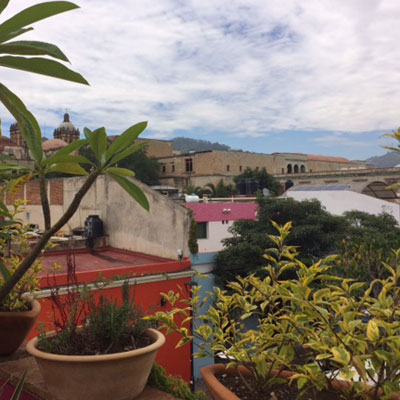
View From the Terrace of La Olla Restaurant
The authors wrote about their visits to the two ancient archaeological sites, Mitla and Monte Alban. Ancient blood pulses through the veins of Mexico at these sites. It is impossible to visit them and not be affected, to feel some of that primeval blood pulsing through your own veins.
Mosby’s Memoirs, published in the New Yorker in 1968, is an imaginative fiction based on the prominent American conservative Willmoore Kendall. Kendall was a Trotskyist whose experiences during the Spanish Civil War led him to renounce his communism and move to the right intellectually. He taught William F. Buckley, Jr. at Yale and later worked with Buckley in founding the National Review. Bellow followed a similar if far more complex political path. He was an artist and not so much interested in politics as in the soul. In the story, Bellow imagines Kendall as Mosby, traveling to Mitla while writing his memoirs.
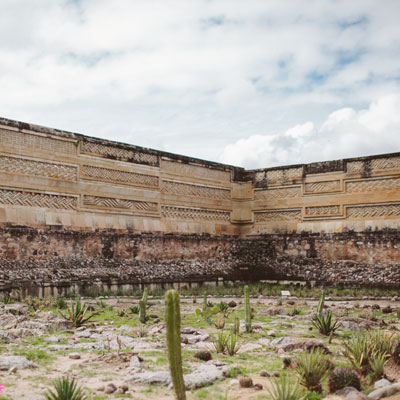
Mitla, Courtesy Las Bugambilias B&B Tours, Rene Cabrera, Nikhol Esteras Photographer
Under the Jaguar Sun, completed in 1986 in Italian and translated into English in 1988, is one of five stories Calvino wanted to write to celebrate the five senses. He only completed three of the five before he died. In this title story, an aging couple whose sex life has come to a halt revives their passion through experiencing the new and strange tastes of Mexico in expected and unexpected ways while visiting Monte Alban.
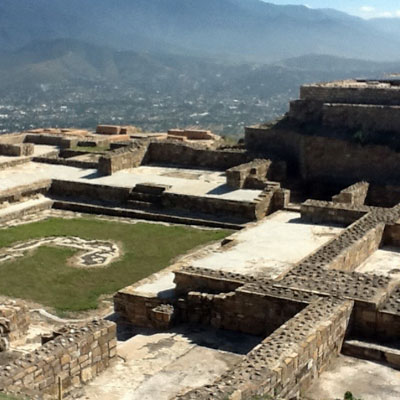
Monte Alban II
Mosby finds himself near the end of a successful career. He is brilliant. He has lived through the important world events of his time. He has met the important people. Once an admirer of Trotsky and a supporter of the Spanish Republic in the Spanish Civil War, he abandoned his communist leanings and moved to the right.
Mosby is disturbed by the vivid, sensual life he finds in Mexico.
“Bougainvillea poured down the hillside, and the hummingbirds were spinning. Mosby felt ill with all this whirling, these colors, fragrances, ready to topple on him. Liveliness, beauty, seemed very dangerous. Mortal danger.”
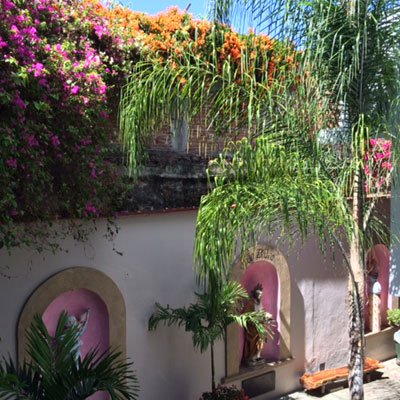
Casa de las Bugambilias Courtyard
Mosby has forfeited the arts for a career in politics and business.
“Mosby the thinker, like other busy men, never had time for music. Poetry was not his cup of tea.”
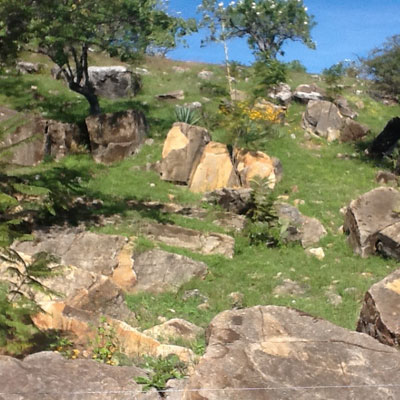
Scattered Ruins, Yagul
Mosby the thinker overpowered Mosby the man. The man knows the thinker is not really so smart. As Sandor, the attorney, tells Herzog in Bellow’s famous novel: “Somewhere in every intellectual is a dumb prick.”
Mosby thinks his memoirs are too serious, too dry. He decides to add some humor to his all too serious life. The way he does this is at the expense of the unfortunate Hymen Lustgarten, the name alone is enough to make you laugh when you first encounter it. Lustgarten, a modern day Pangloss, ventures from one fiasco to another without ever losing his naïve optimism. “Lustgarten could not even hold his own with pushy people in a pissoir.”
While Lustgarten is gallivanting around the world in search of his fortune, thwarted at every turn, Mosby is screwing Lustgarten’s wife, Trudy, in spite of the fact that:
“… to him [Mosby] she was a clown. This need not mean contempt. No, he liked her. The eye seemed to wander in one hemisphere. She did not know how to use perfume. Her atonal compositions were foolish.”
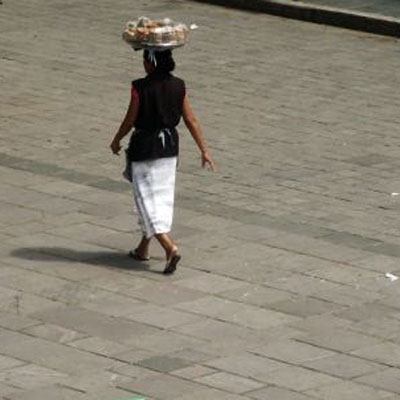
Woman in the Zocalo
“At this time, Mosby had been making fun of people.
“Why?”
“Because he had needed to.”
“Why?”
“Because!””
Mosby is forced to put his memoirs aside to go on a tour to Mitla, the famous Zapotec ruin, the “place the Spanish priests had not destroyed. All others they had razed, building churches on the same sites, using the same stones.”
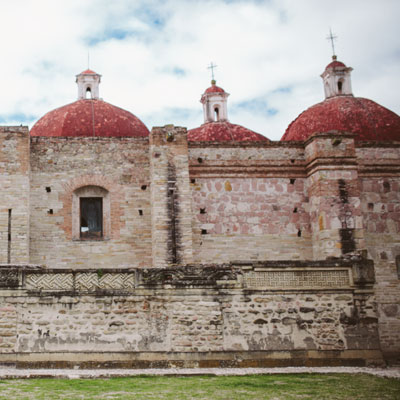
Mitla Church, Courtesy Rene Cabrera, Las Bugambilias B&B Tours, Nikhol Esteras Photographer
A sense of foreboding, of evil, overcomes Mosby at Mitla. He experiences “an odd and complex fantasy… that he was dead. He had died. He continued, however, to live. His doom was to live life to the end as Mosby. In the fantasy, he considered this his purgatory.”
Mosby is aware of another life, but it eludes him. “A most peculiar, ingenious, hungry, aspiring, and heartbroken animal, by calling himself Man, thinks he can escape being what he really is.” Death, impotence—Mosby cannot fight these with his great mental skills alone. He requires the assistance of his emotions, the dreaded emotions, the emotions that are “not his cup of tea.”
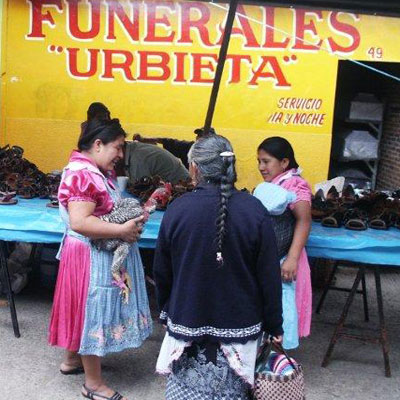
Thacalula Market
He is aware of poetry, of course. Mosby knows his Shakespeare.
“Kingdoms are clay: our dungy earth alike
Feeds beast as man; the nobleness of life
Is to do thus.”
And what is thus? It is “love … or any other sublime option.” Mosby the intellectual knows enough to turn to poetry when confronted with the existential questions.
Bellow once said: “what Americans want to learn from their writers is how to live.” David Foster Wallace put it bluntly, “fiction is about what it is to be a fucking human being.”
Mosby finds the tomb at Mitla oppressive. He hurries out up the stairs before the others so that he can breathe. One wonders what else he might be striving for, “the courage for an attack on his convictions?”
Under the Jaguar Sun is a story about taste. Early in the story, Olivia remarks as if in awe: “Did you taste that? Are you tasting that?” Her passion for food elevates beyond the physiology of taste to the erotic. Later, while exploring the magnificent temples at Monte Alban, that passion finds its dark side. Olivia can’t stop thinking about what happened to the corpses after they were sacrificed by the Aztecs.
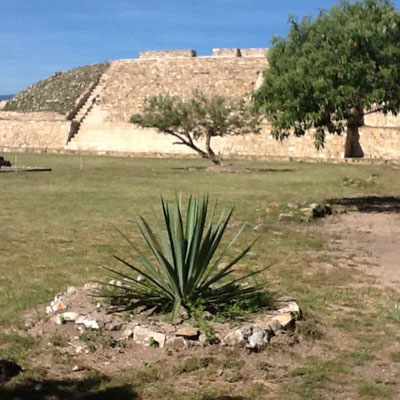
Monte Alban II
Olivia speaks to the guide:
“But what did they do with the victims’ bodies afterward?” Alonso stopped. “Those limbs— I mean, those entrails,” Olivia insisted. “They were offered to the gods, I realize that. But, practically speaking, what happened to them? Were they burned?” No, they weren’t burned. “Well, what then? Surely a gift to the gods couldn’t be buried, left to rot in the ground.” “Los zopilotes,” Alonso said. “The vultures. They were the ones who cleared the altars and carried the offerings to Heaven.” The vultures. “Always?” Olivia asked further, with an insistence I could not explain to myself.
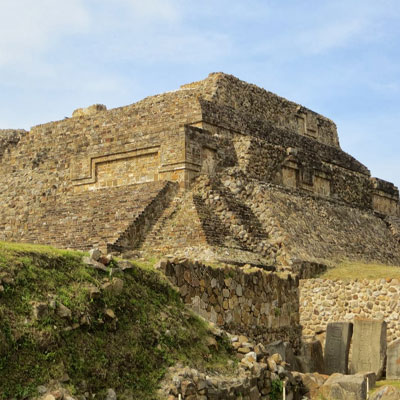
Monte Alban I
Calvino sees an unexpected side of cannibalism. Human relationships are cannibalistic in nature. When you’re human you’re either creating or destroying. This can be a good thing. Calvino imagines this creating and destroying as a way to deepen his relationship with Olivia.
“Olivia’s needs to involve me in her emotions pleased me greatly, because it showed that I was indispensable to her and that, for her, the pleasures of existence could be appreciated only if we shared them. Our subjective, individual selves, I was thinking, find their amplifications and completion only in the unity of the couple.”
Unlike the sense of foreboding felt by Mosby, Olivia is exhilarated after her walk among the tombs. She knows but she wants confirmation about what happens to the victims’ bodies after their hearts are offered to the Gods. She asks her friend, Salustiano. He answers but only partly to her satisfaction.
“Who knows? The priests … This was also a part of the rite— I mean among the Aztecs, the people we know better. But even about them, not much is known. These were secret ceremonies. Yes, the ritual meal … The priest assumed the functions of the god, and so the victim, divine food … Only the warrior who had captured the sacrificed prisoner could not touch his flesh. He remained apart, weeping.”
Olivia presses on wanting the horror (or love) she feels to be complete.
“But this flesh— in order to eat it … The way it was cooked, the sacred cuisine, the seasoning— is anything known about that?”
The questions prove too much for Olivia’s friend, Salustiano. He begs his pardon and leaves. The scene changes. Olivia and Calvino take tranquil strolls around the zocalo and observe the beauty of the trees and flowers and birds.
Later, while eating cabrito (roasted goat kid), Calvino describes the recurrence of a new sensation.
It was the sensation of her teeth in my flesh that I was imagining, and I could feel her tongue lift me against the roof of her mouth, enfold me in saliva, then thrust me under the tips of the canines.
In a strange twist of Camus’ Neither Victim Nor Executioner, Calvino imagines the beauty, even the necessity, of being both at the same time. He asks Salustiano about a stone statue they come upon during a walk.
A stone statue rose barely above the level of the ground, with the unmistakable form that we had learned to recognize on the very first days of our Mexican archeological wanderings: the chacmool, or half-reclining human figure, in an almost Etruscan pose, with a tray resting on his belly. He looks like a rough, good-natured puppet, but it was on that tray that the victims’ hearts were offered to the gods.
“Messenger of the gods— what does that mean?” I asked. I had read that deinition in a guidebook. “Is he a demon sent to earth before the gods to collect the dish with the offering? Or an emissary from human beings who must go to the gods and offer them the food?”
“Who knows?” Salustiano answered, with the suspended attitude he took in the face of unanswerable questions, as if listening to the inner voices he had at his disposal, like reference books. “It could be the victim himself, supine on the altar, offering his own entrails on the dish. Or the sacrificer, who assumes the pose of the victim because he is aware that tomorrow it will be his turn. Without this reciprocity, human sacrifice would be unthinkable. All were potentially both sacrificer and victim— the victim accepted his role as victim because he had fought to capture the others as victims.”
Suddenly Calvino understands.
It was only by feeding ravenously on Olivia that I would cease being tasteless to her palate.
The magic love potion that restores erotic love for Olivia and Calvino is a dish with an unforgettable name:
The dish they had served us was called gorditas pellizcadas con manteca— literally, “plump girls pinched with butter.”
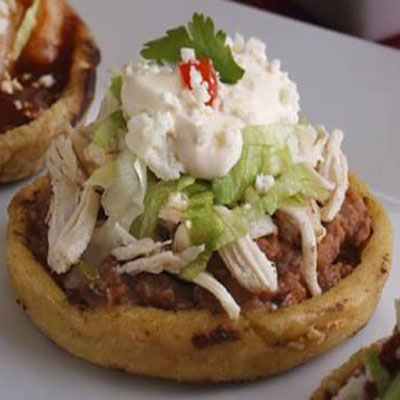
Gorditas Pelizcadas con Manteca
Where Mosby is terrified by the tombs of Mitla, Olivia and Calvino find, to their surprise and delight, that the human sacrifices they learn about do not appall their senses but restore them.
That food takes on a special meaning in this story is apparent from the very beginning.
Olivia spoke. She said, “I would like to eat chiles en nogada.” And, walking like somnambulists, not quite sure we were touching the ground, we headed for the dining room.
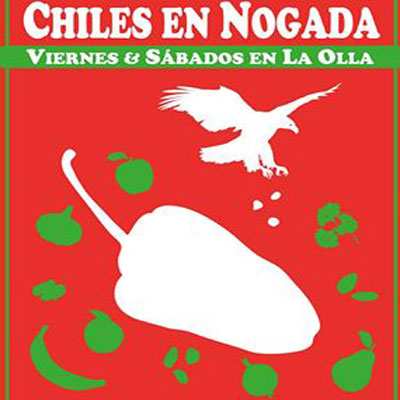
At the end of the story we once again experience the sensations of food shared between the two lovers:
Under the thatched arbor of a restaurant on a riverbank, where Olivia had waited for me, our teeth began to move slowly, with equal rhythm, and our eyes stared into each other’s with the intensity of serpents’— serpents concentrated in the ecstasy of swallowing each other in turn, as we were aware, in our turn, of being swallowed by the serpent that digests us all, assimilated ceaselessly in the process of ingestion and digestion, in the equal rhythm, and our eyes stared into each other’s with the intensity of serpents’— serpents concentrated in the ecstasy of swallowing each other in turn, as we were aware, in our turn, of being swallowed by the serpent that digests us all, assimilated ceaselessly in the process of ingestion and digestion, in the universal cannibalism that leaves its imprint on every amorous relationship and erases the lines between our bodies and sopa de frijoles, huachinango a la vera cruzana, and enchiladas.
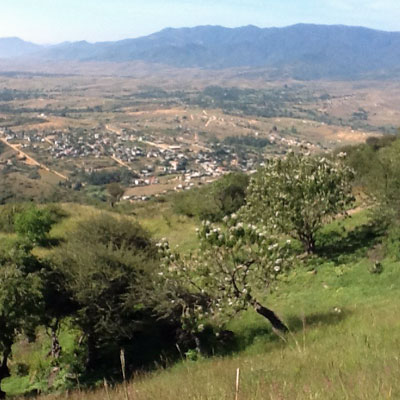
Valle de Oaxaca from Monte Alban
I don’t know if Mosby’s Memoirs and Under the Jaguar Sun will affect you as they did me. But, even if they don’t, you will not waste your time reading them. Two great authors, two good stories, and Oaxaca—that sounds to me as good as “plump girls pinched with butter.” But, who am I to say?
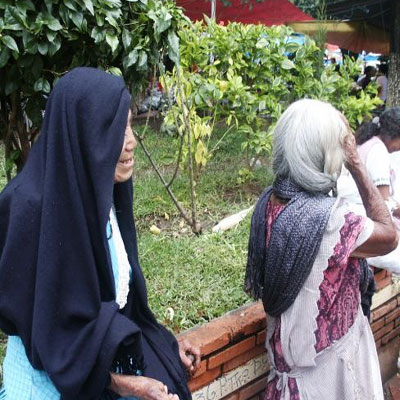
Old Women Telling Stories at the Etla Market

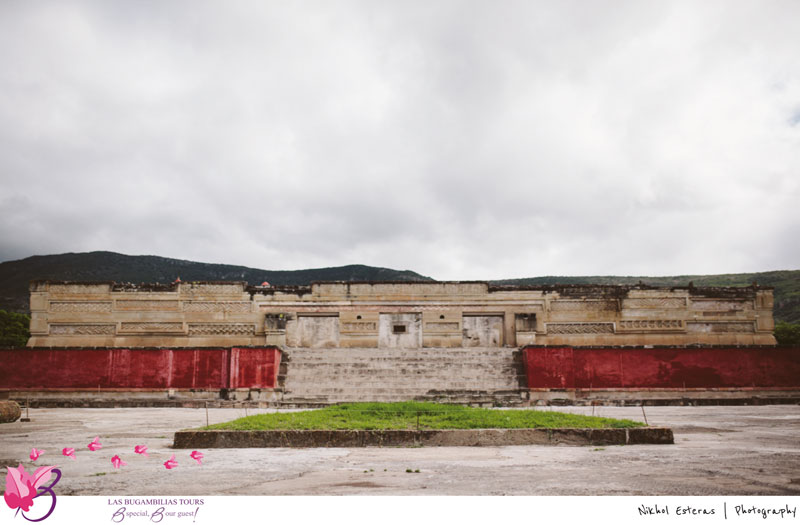
Meaty stuff. Seems like the reader would have to sink his/her teeth into the dense, almost cloying thoughts of both writers to truly experience their meaning. That takes time. You definitely get the sense that Oaxaca has a spell to weave.
You heal my body and my mind, Carole, an almost impossible task. David
I’m thinking “stringy old ladies pinched with butter!”
The Catholic hordes who swept over what would become Latin America were phony dilettante cannibals compared to the local practitioners. I mean, how wussy is “transubstantiation” compared to chomping on actual glistening entrails and still-throbbing hearts? I think the people in Calvino’s and Bellow’s stories were on to this.
Great article, David. Archaeology, literature, human sacrifice and Bon Apetit! Made me hungry–for the food in the pix, and to read those two stories by those two masters.
You have been a wonderful mentor, Eleanor. Anything I do right with the pen is your fault. David
David, do you know the woman I knew who was a friend of Bellow? She was often at the Seagull in the old days, and a participant in one of Victor’s groups. Just remembered: Bobby Markels!
Correct. Bobby published her fabulous book just before she died. You should read it, wonderful. https://www.amazon.com/Seduction-Nonny-Stein-Roberta-Markels-ebook/dp/B00N21HX68/ref=sr_1_3?s=books&ie=UTF8&qid=1505262584&sr=1-3&keywords=Roberta+Markels